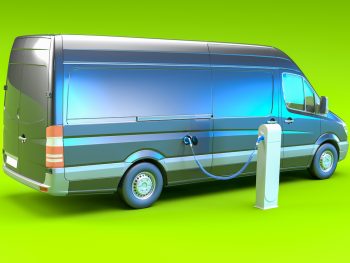The Government has announced that it will drop driver training requirements for heavier vans to help fleets go zero-emission, while also confirming it’s extending the Plug-in Van Grant (PiVG) for a further year.

The Department for Transport (DfT) said it was making it easier to switch to zero-emission vehicles, by bringing driving licence rules for heavier ZEVs in line with their petrol and diesel equivalents, as pledged by the former Conservative government.
Alternatively fuelled vans weighing from 3.5 tonnes to 4.25 tonnes already have a gross vehicle weight derogation that enables individuals with a Category B (passenger car) licence to drive them, but licence holders must still undertake five hours of additional training before being permitted to operate them. The DfT has now laid secondary legislation before Parliament to enable standard category B licence holders to be able to drive zero-emission vehicles up to 4.25 tonnes, accounting for the additional weight of their batteries and removing the training requirement. Drivers will also be able to tow using a 4.25 tonne ZEV.
Subject to parliamentary approval, the change is expected to come into force in the spring, helping businesses by taking away training costs, cutting red tape and making it easier to hire drivers when operating electric vans.
The training change was announced in October 2023 by the Office of Zero Emission Vehicles (OZEV) as one of four proposed updates following a consultation on driving licence flexibility for alternatively fuelled vehicles but legislation to back the move was not passed.
A DfT consultation on Zero-emission vans: regulatory flexibility remains open until 3 March 2025 and explores changing current rules whereby 4.25-tonne electric vans are treated as HGVs in terms of MOT and driver hours requirements.
The Department for Transport has also confirmed the PiVG extension, first announced in the Autumn Budget.
Backed by £120m cash, the move will mean businesses and van drivers can receive grants up to £2,500 when buying small vans up to 2.5 tonnes and up to £5,000 for larger vans up to 4.25 tonnes across 2025/26. The grant is available on eligible vehicles and with the discount included by the seller in the purchase price.
Launched in 2012, the Plug-in Van Grant has helped sell over 80,000 electric and zero emission vans since its launch.
Finally, the DfT also announced today that it’s continuing the Plug-in Taxi Grant for another year to help drivers make the switch to electric, although the grant level is being reduced from £6,000 to £4,000.
It’s also increasing the Plug-in Wheelchair Accessible Vehicle Grant cap from £35,000 to £50,000, giving consumers a wider choice of vehicle models and removing barriers for disabled passengers.
And bikers will be able to use a £500 grant from Government to buy an electric motorbike for another year under the extended Plug-in Motorcycle Grant (PiMG).
Future of Roads Minister Lilian Greenwood said: “From van drivers and businesses, to drivers with accessibility needs, bikers and cabbies, today we are making it easier, faster and cheaper for people to switch to electric vehicles.
“By making the transition to zero emissions a success, we’re helping to drive growth all over the UK, putting more money in people’s pockets and rebuilding Britain to deliver our Plan for Change.”
Logistics UK welcomed today’s changes, highlighting that the extra training needed to operate electric vans was an additional expense for thousands of van operators and a significant barrier for operators looking to integrate zero emission vehicles into their fleets.
But the industry body also called for full regulatory alignment between 4.25-tonne electric vans and 3.5-tonne diesel vans.
Chris Yarsley, senior policy manager – road freight regulation, said: “Removing the need for additional training to operate electric vans and aligning towing regulations with equivalent-sized ICE vans will help our members, and the industry in general, integrate zero-emission vehicles into their fleets.
“It is the first step to achieving the full regulatory alignment between 4.25-tonne electric vans and 3.5-tonne diesel vans, which Logistics UK as part of the Zero Emission Van Plan coalition has long been campaigning for, and will speed up the adoption of electric vehicles.”
Yarsley also said the current situation, where 4.25-tonne electric vans are treated differently to their ICE counterparts, is “nonsensical” and is limiting the use of cleaner electric vehicles.
“The vehicles are the same size and perform the same tasks as traditional vans: it is only the extra weight from the batteries which moves them into a heavier weight category with additional regulations.”
He added: “Vans are the workhorses of the UK economy and all barriers to their use need to be removed so drivers can use a zero-emission van just as easily as a petrol or diesel equivalent.”
The Zero Emission Van Plan, launched one year ago by a coalition of industry representatives to campaign for fiscal support and regulatory barrier removal, said it was encouraging to see policymakers starting to take the transition to zero-emission vans more seriously.
A spokesperson for the group, which includes the BVRLA, Logistics UK and the Association of Fleet Professionals (AFP) among others, said: “Today marks a positive step forward but there remains a long way to go. Electric van registrations are far short of where they need to be; a host of regulatory barriers remain.
“We have been in constant contact with decision-makers to reinforce the case for vans. The ongoing consultation, into the need for further regulatory flexibilities, presents another key milestone where we need to see positive progress.
“It is good to see the Government taking action. Now we must make sure we accelerate further and faster.”

